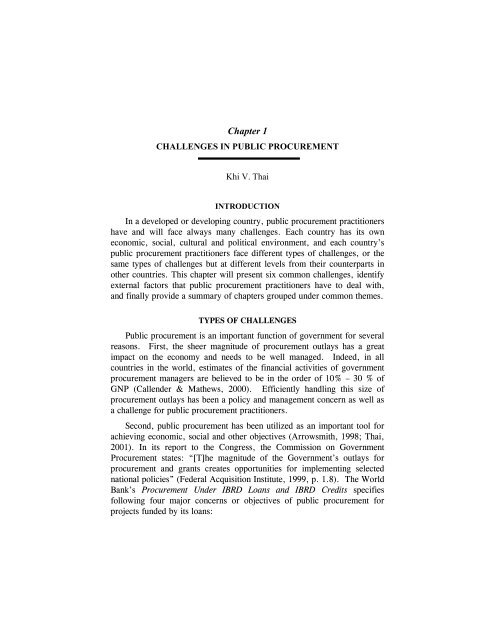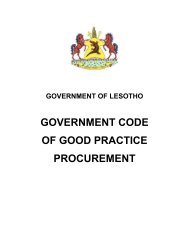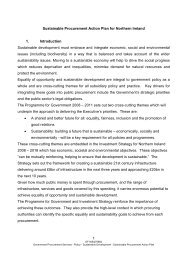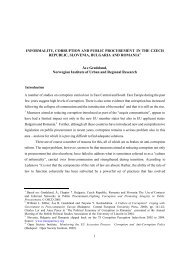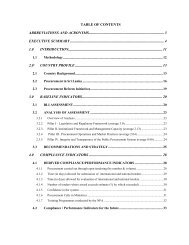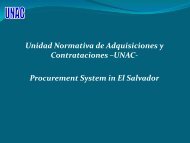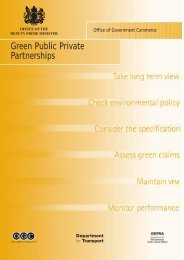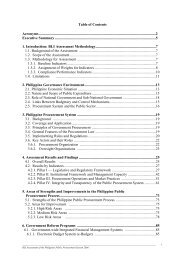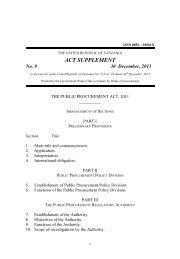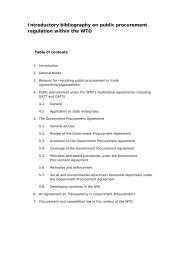Challenges in Public Procurement - unpcdc
Challenges in Public Procurement - unpcdc
Challenges in Public Procurement - unpcdc
You also want an ePaper? Increase the reach of your titles
YUMPU automatically turns print PDFs into web optimized ePapers that Google loves.
Chapter 1CHALLENGES IN PUBLIC PROCUREMENTKhi V. ThaiINTRODUCTIONIn a developed or develop<strong>in</strong>g country, public procurement practitionershave and will face always many challenges. Each country has its owneconomic, social, cultural and political environment, and each country’spublic procurement practitioners face different types of challenges, or thesame types of challenges but at different levels from their counterparts <strong>in</strong>other countries. This chapter will present six common challenges, identifyexternal factors that public procurement practitioners have to deal with,and f<strong>in</strong>ally provide a summary of chapters grouped under common themes.TYPES OF CHALLENGES<strong>Public</strong> procurement is an important function of government for severalreasons. First, the sheer magnitude of procurement outlays has a greatimpact on the economy and needs to be well managed. Indeed, <strong>in</strong> allcountries <strong>in</strong> the world, estimates of the f<strong>in</strong>ancial activities of governmentprocurement managers are believed to be <strong>in</strong> the order of 10% – 30 % ofGNP (Callender & Mathews, 2000). Efficiently handl<strong>in</strong>g this size ofprocurement outlays has been a policy and management concern as well asa challenge for public procurement practitioners.Second, public procurement has been utilized as an important tool forachiev<strong>in</strong>g economic, social and other objectives (Arrowsmith, 1998; Thai,2001). In its report to the Congress, the Commission on Government<strong>Procurement</strong> states: “[T]he magnitude of the Government’s outlays forprocurement and grants creates opportunities for implement<strong>in</strong>g selectednational policies” (Federal Acquisition Institute, 1999, p. 1.8). The WorldBank’s <strong>Procurement</strong> Under IBRD Loans and IBRD Credits specifiesfollow<strong>in</strong>g four major concerns or objectives of public procurement forprojects funded by its loans:
2 THAI- Ensur<strong>in</strong>g that the loan is used to buy only those goods and servicesneeded for the project;- Ensur<strong>in</strong>g fair competition for all qualified bidders from the WorldBank’s eligible countries;- Promot<strong>in</strong>g transparency or <strong>in</strong>tegrity; and- Encourag<strong>in</strong>g development of <strong>in</strong>digenous contractors and manufacturersby allow<strong>in</strong>g local buyers to build <strong>in</strong> a marg<strong>in</strong> of preference for localcontractors and manufacturers (Tucker, 1998).Third, due to many reasons (<strong>in</strong>clud<strong>in</strong>g greater scrut<strong>in</strong>y of taxpayers andcompet<strong>in</strong>g vendors), public procurement has been perceived as an area ofwaste and corruption. The District of Columbia, USA government wastedhundreds of thousands of dollars <strong>in</strong> revenue by sell<strong>in</strong>g used emergencyvehicles for “barga<strong>in</strong> basement prices” <strong>in</strong> auctions run by untra<strong>in</strong>ed staffers(Nakamura, 2004). In a 2 1/2-year period studied by the city’s InspectorGeneral's Office, the city sold 11 fire trucks for a total of $3,125 whilesimilar vehicles <strong>in</strong> make and model had been sold on the Internet for a totalof $360,875. Corruptions and bribes are widespread <strong>in</strong> government contracts(International Transparency, undated; and see www.transparency.org). Inthe United States, corruptions <strong>in</strong> government contracts have been regularlyreported <strong>in</strong> newspapers; and the first week of September 2004 witnessed thereport<strong>in</strong>g of a flurry of crim<strong>in</strong>al prosecutions aga<strong>in</strong>st state officials forviolations of state procurement laws. Separate newspapers reported onbidd<strong>in</strong>g scandals from Ill<strong>in</strong>ois, Connecticut, Wiscons<strong>in</strong>, and Maryland (seewww.aba.org). Similar newspaper reports can be found <strong>in</strong> many countries.Overcom<strong>in</strong>g the negative perception -- and the objective reality, to a certa<strong>in</strong>extent – is one of the biggest challenges <strong>in</strong> public procurement.Fourth, as many countries have moved to a regional and or globaleconomy, public procurement practitioners face another challenge, that is,how to comply with their government’s procurement regulations and socialand economic procurement goals without violat<strong>in</strong>g regional and/or<strong>in</strong>ternational trade agreements. For example, how to comply with nationaleconomic policies (<strong>in</strong> nurtur<strong>in</strong>g domestic firms), without deal<strong>in</strong>g unfairlywith foreign firms as provided <strong>in</strong> regional trade agreements and/or theWorld Trade Organization (WTO) agreements is not easy, which requiresa careful study of trade agreements <strong>in</strong> order to take advantages of specialprovisions. The WTO Agreement on Government <strong>Procurement</strong> (GPA)Article XVI provides: “Entities shall not, <strong>in</strong> the qualification and selectionof suppliers, products or services, or <strong>in</strong> the evaluation of tenders and award
CHALLENGES IN PUBLIC PROCUREMENT 3of contracts, impose, seek or consider offsets.” Without careful exam<strong>in</strong>ationof GPA provisions, procurement practitioners <strong>in</strong> develop<strong>in</strong>g countries maynot use an exception: However, GPA Article XVI.2 “expressly allows forthe use of offsets by develop<strong>in</strong>g countries” (Arrowsmith, 2003, p.165).Properly us<strong>in</strong>g ‘offsets’ is a major challenge 1 for public procurementpractitioners. Similarly, the World Trade Organization's general rulerequir<strong>in</strong>g that contracts be advertised for a period of no less than 40 daysfrom the date of publication of the notice to the tender submission deadl<strong>in</strong>e.The 40-day requirement would h<strong>in</strong>der a speedy procurement. The 40-daystandard period, however, may be reduced <strong>in</strong> certa<strong>in</strong> cases to 24 days or 10days, as set out <strong>in</strong> GPA Article XI.3.Fifth, <strong>in</strong> developed as well as develop<strong>in</strong>g countries, disregard<strong>in</strong>g theireconomic, social, and political environment, a sound procurement systemhas accomplish two sets of requirements: management requirements andpolicy requirements. The procurement management requirementsnormally <strong>in</strong>clude quality, timel<strong>in</strong>ess, cost (more than just the price),m<strong>in</strong>imiz<strong>in</strong>g bus<strong>in</strong>ess, f<strong>in</strong>ancial and technical risks, maximiz<strong>in</strong>gcompetition, and ma<strong>in</strong>ta<strong>in</strong><strong>in</strong>g <strong>in</strong>tegrity. The procurement policyrequirements normally <strong>in</strong>clude economic goals (preferr<strong>in</strong>g domestic orlocal firms), environment protection or green procurement (promot<strong>in</strong>g theuse of recycled goods), social goals (assist<strong>in</strong>g m<strong>in</strong>ority and woman-ownedbus<strong>in</strong>ess concerns), and <strong>in</strong>ternational trade agreements. It is very difficultfor policy makers and public procurement practitioners to make an optimaldecision, as there are always tradeoffs among these goals (FederalAcquisition Institute, 1999; Thai, 2001).F<strong>in</strong>ally, fac<strong>in</strong>g the challenges above and others, <strong>in</strong>clud<strong>in</strong>g rapiddevelopments <strong>in</strong> technology (which have led to new procurementmethods), public procurement cannot be perceived as mere a ‘clericalrout<strong>in</strong>e,’ as procurement practitioners are and should be <strong>in</strong>volved <strong>in</strong>strategic procurement plann<strong>in</strong>g (Office of Management and Budget, 1997;H<strong>in</strong>son & McCue, 2004). In recent years, public procurement practitionershave forcefully challenged the perceived clerical task of public procurement.Accord<strong>in</strong>g to a recent unscientific survey of 704 members at the NationalInstitute of Governmental Purchas<strong>in</strong>g, Inc., 83% of respondents contendedthat the major role of current purchas<strong>in</strong>g is tactical (www.nigp.org). Thus,mak<strong>in</strong>g public procurement a recognized profession is another challenge.Build<strong>in</strong>g a body of public procurement knowledge, one of attributes of aprofession, is very critical. The National Institute of GovernmentalPurchas<strong>in</strong>g, Inc. (NIGP), a national professional association of the UnitedStates and Canada signed a partnership agreement with Florida Atlantic
CHALLENGES IN PUBLIC PROCUREMENT 5procurement function <strong>in</strong> operations (processes, methods, organizationalstructure, and procurement workforce; and feedback) (Figure 1). <strong>Public</strong>procurement practitioners have always walked on a tight rope. Theirability to accomplish procurement objectives and policies is <strong>in</strong>fluencedvery much by <strong>in</strong>ternal forces <strong>in</strong>clud<strong>in</strong>g: 4- Interactions between various elements (as depicted by the five boxes <strong>in</strong>Figure 1) of the public procurement systems, various officials andorganizations <strong>in</strong> the three branches of government, and various actorsand sub-agencies with<strong>in</strong> a department or executive agency and actorsand organizations external to sub-agencies;- Types of goods, services and capital assets required for an agency'smissions;- Professionalism or quality of procurement workforce;- Staff<strong>in</strong>g levels (e.g., ratio of procurement practitioners to contractactions) and budget resources;
6 THAIFIGURE 1<strong>Public</strong> <strong>Procurement</strong> SystemPolicy Mak<strong>in</strong>g and Management(Box 1)Authorizations andAppropriations (Box 3)Accountable<strong>Procurement</strong> Regulations(Box 2)<strong>Procurement</strong> Function <strong>in</strong>Operations (Box 4)Legend:Feedback (Box 5)Direct relationshipFeedback and reforms/adjustmentsSource: Thai (2001).- <strong>Procurement</strong> organizational structure such as the issue of centralizationvs. decentralization;- <strong>Procurement</strong> regulations, rules and guidance; and- Internal controls and legislative oversight.PUBLIC PROCUREMENT CHALLENGES: EXTERNAL FACTORS<strong>Public</strong> procurement practitioners have always faced challengesimposed upon by a variety of environment factors <strong>in</strong>clud<strong>in</strong>g market, legalenvironment, political environment, organizational environment, andsocio-economic and other environmental factors.Market Environment
CHALLENGES IN PUBLIC PROCUREMENT 7Market conditions have a great <strong>in</strong>fluence on public procurementpractitioners’ effort to maximize competition. Moreover, the marketdeterm<strong>in</strong>es whether or not socio-economic objectives of procurement areaccomplished, whether or not a governmental entity can fulfill its needs;the timel<strong>in</strong>ess of fulfillment; and the quality and costs of purchased goods,services and capital assets. As there are different levels of economicgrowth among countries <strong>in</strong> the world, market conditions are very favorable<strong>in</strong> <strong>in</strong>dustrialized countries, while they may be unfavorable <strong>in</strong> develop<strong>in</strong>gcountries.Even under a perfectly competitive condition like that <strong>in</strong> the UnitedStates, some supplies and services are required only by the government(particularly for weapons systems) and are available <strong>in</strong> the market. This isa captive market, which is limited <strong>in</strong> scope and competition.Also as markets become more and more globalized through regionaland <strong>in</strong>ternational trade agreements and treaties, public procurementpractitioners face a greater challenge. In addition to compliance with theirgovernments’ procurement laws and policies and <strong>in</strong>ternational traderequirements as mentioned above, they face additional challenges <strong>in</strong>clud<strong>in</strong>gcommunication, currency exchange rates and payment, customsregulations, lead-time, transportation, foreign government regulations,trade agreements, and transportation. Thus, “before embark<strong>in</strong>g on aforeign purchas<strong>in</strong>g program, public procurement practitioners mustcarefully assess the total cost implications and compare them to domesticcosts” (National Institute of Governmental Purchas<strong>in</strong>g, Inc., 1999, p. 34).<strong>Public</strong> procurement practitioners are torn between free trade agreementsand their countries' economic development/stabilization policies when theyface a hard choice between select<strong>in</strong>g domestic or foreign firms.Legal EnvironmentApart from public procurement regulations and rules, the legalenvironment refers to a broad legal framework that governs all bus<strong>in</strong>essactivities <strong>in</strong>clud<strong>in</strong>g research and development (regulations deal<strong>in</strong>g withsafety and health of new products), manufactur<strong>in</strong>g (safety and healthregulations at workplace and pollution control), f<strong>in</strong>ance (regulationsdeal<strong>in</strong>g with disclosure of <strong>in</strong>formation), market<strong>in</strong>g (regulations deal<strong>in</strong>gwith deceptive advertis<strong>in</strong>g, disclosure of product characteristics),personnel (regulations deal<strong>in</strong>g with equal opportunity for women andm<strong>in</strong>orities), and contracts. Indeed, most aspects of contracts--public orprivate-- such as contract requirements, disputes, and breach of contract
8 THAIare governed under the same contract law. In develop<strong>in</strong>g and particularlytransitional countries, where legal systems are not comprehensive,government contracts may need detailed provisions.Political EnvironmentIn a democracy many <strong>in</strong>dividuals, groups, and organizations <strong>in</strong> theprivate sector <strong>in</strong>clud<strong>in</strong>g trade associations, professional associations, andbus<strong>in</strong>ess firms or companies (commonly known as <strong>in</strong>terest groups) areactively <strong>in</strong>volved <strong>in</strong> all aspects of the public procurement system. Hav<strong>in</strong>gvarious <strong>in</strong>terests, objectives and beliefs, <strong>in</strong>terest groups are <strong>in</strong>volved <strong>in</strong> thepublic procurement system <strong>in</strong> several ways such as lobby<strong>in</strong>g legislativebodies to pass or alter procurement statutes, <strong>in</strong>fluenc<strong>in</strong>g implementation ofthese statutes, and <strong>in</strong>fluenc<strong>in</strong>g budget authorization and appropriationsprocesses. Normally, a government program that is eventually adopted isa compromise among different views of <strong>in</strong>terest groups, policy makers andmanagement. In this democratic environment, there are cases of a strongcoalition of policy makers, bureaucrats and <strong>in</strong>terest groups <strong>in</strong> their effortto get their programs adopted. This coalition has led to the concept of the‘iron triangle,’ which is very popular <strong>in</strong> the area of defense procurement(see Thai [2001] for further explanation).However, the iron triangle shifts immediately after the procurementprogram authorization and appropriations stages to move to theprocurement stage. As failure or success <strong>in</strong> w<strong>in</strong>n<strong>in</strong>g large defensecontracts has a great impact on a company, defense specialized companiescompete aga<strong>in</strong>st each other for these contracts. <strong>Public</strong> procurementpractitioners have choices as they face various political pressures as well assound economic decisions. For example, should they be concerned withma<strong>in</strong>ta<strong>in</strong><strong>in</strong>g future bus<strong>in</strong>ess competition by keep<strong>in</strong>g some relatively weakcompanies <strong>in</strong> bus<strong>in</strong>ess or should they let these small weak firms go out ofbus<strong>in</strong>ess and leave a few defense-specialized firms to compete forcontracts? This issue is more common <strong>in</strong> develop<strong>in</strong>g countries whereperfect competition hardly exists. Large firms are more will<strong>in</strong>g to make asmall profit marg<strong>in</strong> or even to take bus<strong>in</strong>ess losses by offer<strong>in</strong>g best bids.After small and weak firms are out of bus<strong>in</strong>ess, they will enjoy animperfect competitive market.Social, Economic, and Other Environment ForcesWhile some countries impose social policies on their publicprocurement practices (such as a policy plac<strong>in</strong>g a fair proportion of
CHALLENGES IN PUBLIC PROCUREMENT 9government acquisitions with woman/m<strong>in</strong>ority-owned small bus<strong>in</strong>ess, oreconomically disadvantaged areas), most governmental entities --be it adeveloped or develop<strong>in</strong>g country or federal, state, and local governments--use their large procurement outlays for economic stabilization ordevelopment purposes by preferr<strong>in</strong>g national or local firms over firmsfrom other countries or other geographic locations. <strong>Public</strong> procurementpractitioners may be <strong>in</strong> a favorable economic environment or market (withmany compet<strong>in</strong>g tenderers <strong>in</strong> their country or local areas) or anunfavorable economic environment (where competition hardly exists).This environment would have a great impact on their practices as they mayface an imperfect competitive market.In addition to social and economic environment, public procurementpractitioners are under other external pressures such as an environmentprotection movement, and foreign policy commitments.Environmental Protection Concern or Green <strong>Procurement</strong>. Environmentprotection has been present <strong>in</strong> every country-- developed and develop<strong>in</strong>g--and environmentalists have placed a great deal of pressure on publicprocurement practitioners. This type of pressure can be seen frequentlyand across countries. In late 2001, the Vietnamese central government’sState Appraisal Committee approved a controversial plan to build a newnorth-south highway through the country's oldest national park, a habitatfor many rare and endangered plant and animal species. Accord<strong>in</strong>g toenvironmental groups, the plan to run the highway through the CucPhuong park, which starts about 56 miles south of Hanoi, posed a seriousthreat to endangered species. The Cuc Phuong park is a global center forplant diversity and home to Delacour's Langur, a critically endangeredprimate, as well as the grey-headed fish eagle, tigers and elephants. Thecommittee had exam<strong>in</strong>ed two options: to upgrade an exist<strong>in</strong>g road runn<strong>in</strong>gthrough the west of the park <strong>in</strong>to a 17 miles stretch of highway, or to builda new road, skirt<strong>in</strong>g the park. The latter road would be 12 miles longer,cost nearly $20 million more and require the relocation of more than 900families <strong>in</strong>stead of 80. The Vietnamese government, concerned with costsav<strong>in</strong>gs, decided to build the new road.Foreign Policy. Many countries have used public procurement as a tool toachieve specific foreign policies. For example, <strong>in</strong> the 1980s, the Pakistanigovernment bought 28 F-16 fighter jets, but the United States governmentwithheld the contract because Pakistan was pursu<strong>in</strong>g, aga<strong>in</strong>st Americanwishes, the development of nuclear weapons. <strong>Public</strong> procurementpractitioners <strong>in</strong> poor and weak countries are frequently fac<strong>in</strong>g the problem
10 THAIof hav<strong>in</strong>g to deal with the foreign policy of other nations <strong>in</strong> theirprocurement decisions.Other Environmental Forces. The public procurement system is also<strong>in</strong>fluenced by culture and technology. In a culture where giv<strong>in</strong>g gifts is acommon public relation practice, it is difficult to dist<strong>in</strong>guish between giftsand bribes. Moreover, rapidly advanced technology has forced publicprocurement to (a) adopt new procurement methods, such as the use of e-signature and purchase cards; and (b) be knowledgeable <strong>in</strong> many aspectsand considerations of how to procure <strong>in</strong>formation technology. 5Interactions of Environment ForcesVarious pressures on the public procurement system, as describedabove, are not constant variables, but they <strong>in</strong>teract with each other andbecome conflict<strong>in</strong>g forces that public procurement practitioners have todeal with. There are tradeoffs between the environment forces, and thesepractitioners have to seek an optimum solution. These tradeoffs <strong>in</strong> manycases are the most challeng<strong>in</strong>g decisions that public procurementpractitioners are fac<strong>in</strong>g.As mentioned earlier, each country has its own economic, social,cultural and political environment, and each country’s public procurementpractitioners face different types of challenges, or the same types ofchallenges but at different levels compared to their counterparts <strong>in</strong> othercountries. This book does not <strong>in</strong>tend to cover all areas of challenges thatpublic procurement practitioners <strong>in</strong> the world are fac<strong>in</strong>g. Papers published<strong>in</strong> this book were selected, through a rigorous peer-review process, from atotal of 46 papers presented at the 2004 International <strong>Public</strong> <strong>Procurement</strong>Conference. They can be grouped under some two major themes:procurement reforms and lessons learned.<strong>Public</strong> <strong>Procurement</strong> ReformPUBLIC PROCUREMENT CHALLENGES:AN INETRNATIONAL PERSPECTIVEAccord<strong>in</strong>g to Arrowsmith and Trybus (2003, p. ix), “the last decade ofthe twentieth century had witnessed the start of a ‘global revolution’ <strong>in</strong> theregulation of public procurement.” Actually, challenges <strong>in</strong> procurementreforms are beyond procurement regulations to <strong>in</strong>clude procurementprocess, methods, procurement organizational structure, and workforce.<strong>Procurement</strong> reforms occur constantly <strong>in</strong> all countries, developed as well as
CHALLENGES IN PUBLIC PROCUREMENT 11develop<strong>in</strong>g countries. The scope of reforms varies, from reform<strong>in</strong>g thewhole procurement system if the system is completely dysfunctional such asthe on-go<strong>in</strong>g procurement <strong>in</strong> Sierra Leone after a long civil war (Elliott,2004) and the successful reform <strong>in</strong> Gambia (see Chapter 2), or fix<strong>in</strong>g somenarrow areas <strong>in</strong> a well-developed procurement system <strong>in</strong> developedcountries.In “<strong>Challenges</strong> <strong>in</strong> <strong>Public</strong> <strong>Procurement</strong>: Comparative Views of <strong>Public</strong><strong>Procurement</strong> Reform <strong>in</strong> Gambia,” Wayne A. Wittig and Habib Jeng describehow procurement reform was implemented <strong>in</strong> The Gambia. Through a jo<strong>in</strong>teffort of the World Bank, Government of The Gambia and the InternationalTrade Centre WTO/UNCTAD (ITC), a team of procurement expertsdeveloped a comprehensive approach to modernize the public procurementsystem of The Gambia <strong>in</strong> a model comb<strong>in</strong><strong>in</strong>g elements of a Central TenderBoard with a <strong>Procurement</strong> Policy Office. Local capacity is be<strong>in</strong>g developed<strong>in</strong> the Gambia <strong>Public</strong> <strong>Procurement</strong> Authority and <strong>in</strong> the Procur<strong>in</strong>gOrganizations to support transparent public procurement systems. Positiveand objective changes lie <strong>in</strong> the new legal, regulatory and organizationalframework as demonstrated by a survey of <strong>Procurement</strong> Organizations.Nevertheless, challenges rema<strong>in</strong> <strong>in</strong> extend<strong>in</strong>g and susta<strong>in</strong><strong>in</strong>g the reforms.Maria Krist<strong>in</strong>a Villanueva Pimentel, <strong>in</strong> “<strong>Procurement</strong> Watch, Inc.: TheRole of Civil Society <strong>in</strong> <strong>Public</strong> <strong>Procurement</strong> Reforms <strong>in</strong> the Philipp<strong>in</strong>es,”highlights the role of <strong>Procurement</strong> Watch Inc. (PWI), a civil societyorganization, which was at the forefront of the advocacy for the Government<strong>Procurement</strong> Reform Act (GPRA). Prior to the passage of the GPRA, therewere over a hundred guidel<strong>in</strong>es govern<strong>in</strong>g public procurement. The GPRAsought to standardize and <strong>in</strong>stitutionalize procurement reforms and addressthe lack of transparency and accountability that have long plagued thePhilipp<strong>in</strong>e government <strong>in</strong> its procurement. To steer the process of change,support from the highest levels of leadership <strong>in</strong> the government and theprivate sector were found to be essential. PWI became the cog that l<strong>in</strong>keddifferent branches of government, and garnered support from the privatesector.In “Reform<strong>in</strong>g <strong>Public</strong> <strong>Procurement</strong> Sector <strong>in</strong> Turkey,” Kadir Akın Gözelprovides basic <strong>in</strong>formation about the public procurement reform <strong>in</strong> Turkeyand to evaluate the results of it for the last two years. Turkey underwent amajor public procurement reform two years ago. In Turkey, the governmentspends around U.S. $25 billion on purchased goods, services andconstruction works each year. It can be easily understood how vital it is tohave a transparent and competitive public procurement system for thecountry. This essay presents both a comparison of the public procurement
12 THAIlegislation before and after the reform and a comparison of some aspects ofa newly <strong>in</strong>troduced system with some developed countries’ publicprocurement systems.In December 2003 the Canadian Prime M<strong>in</strong>ister <strong>in</strong>itiated acomprehensive review of Canada’s federal procurement, to ensure a “best ofbreed” approach with demonstrated high value for Canadian taxpayers, andcreated the Canada Parliamentary Secretary’s Task Force on Government-Wide Review of <strong>Procurement</strong> for this purpose. In “Government-WideReview of <strong>Procurement</strong>: Redesign<strong>in</strong>g Canadian <strong>Procurement</strong>,” the TaskForce on Government-Wide Review of <strong>Procurement</strong> reported on the work ofthe Task Force to date (mid-way to its planned December 2004 report andrecommendations), and set out its <strong>in</strong>itial conclusions. This government-widereview had exam<strong>in</strong>ed all aspects of procurement, from fundamentalconcepts such as fairness and open competition, through procurementprocesses and organization, to management oversight and publicaccountability.U. S. Federal procurement agencies have many socioeconomic, and <strong>in</strong>particular, small bus<strong>in</strong>ess goals, but these goals are currently measured on as<strong>in</strong>gle metric: the percentage of total agency dollars that are awarded tosmall bus<strong>in</strong>ess. F<strong>in</strong>d<strong>in</strong>g the balance between the benefits of publicprocurement reform and benefits derived from small bus<strong>in</strong>ess participationis a public policy challenge. In “Balanc<strong>in</strong>g Socioeconomic and <strong>Public</strong><strong>Procurement</strong> Reform Goals: Effective Metrics for Measur<strong>in</strong>g SmallBus<strong>in</strong>ess Participation <strong>in</strong> <strong>Public</strong> <strong>Procurement</strong>,” Timothy S. Reed, Patricia G.Luna, William C. Pike support the argument that <strong>in</strong> order to accuratelymeasure small bus<strong>in</strong>ess participation <strong>in</strong> a ‘trans-procurementtransformation” environment, more effective metrics are required. In thechapter, the authors exam<strong>in</strong>ed the effectiveness of the exist<strong>in</strong>g metrics andevaluated the effectiveness of two new proposed metrics. They found thatthe exist<strong>in</strong>g metrics are <strong>in</strong>effective and that the new metrics measure smallbus<strong>in</strong>ess participation with greater efficacy.Lessons Learned: Understand<strong>in</strong>g Current <strong>Public</strong> <strong>Procurement</strong>The evolution of procurement, from a bureaucratic, manual process toan IT systems-based approach has not obviated the apparent need tocont<strong>in</strong>ue the search for a perfect public procurement system. In “A Tale ofTwo Cities <strong>in</strong> the Search for the Perfect <strong>Procurement</strong> System,” GuyCallender and Jim McGuire exam<strong>in</strong>e the way <strong>in</strong> which two state-basedjurisdictions <strong>in</strong> Australia have sought to develop their unique versions of aperfect procurement system. Apart from the classic management choices
CHALLENGES IN PUBLIC PROCUREMENT 13between centralized or decentralized procurement platforms, theprocurement policy choices, represented by lowest purchase price or valuefor-money,also have to be resolved. Conflict<strong>in</strong>g demands <strong>in</strong>clude the needto enhance government management of procurement with<strong>in</strong> the constra<strong>in</strong>tsof a tender-driven contract<strong>in</strong>g policy framework, while assur<strong>in</strong>g high levelsof probity, accountability and transparency, whilst also satisfy<strong>in</strong>g the diversegovernance expectations of stakeholders.<strong>Public</strong>/private partnerships have become more and more popular <strong>in</strong>public procurement, accord<strong>in</strong>g to Alexander Batran, Michael Essig, andBerthold Schefer, <strong>in</strong> “<strong>Public</strong>-Private Partnerships As an Element of <strong>Public</strong><strong>Procurement</strong> Reform <strong>in</strong> Germany.” Just like <strong>in</strong> other countries,public/private partnerships (PPPs) are becom<strong>in</strong>g <strong>in</strong>creas<strong>in</strong>gly more popular<strong>in</strong> Germany. At the moment, there are several cases which give deep<strong>in</strong>sights <strong>in</strong>to the success factors of PPPs. As a result, PPPs are also seen asone key element for reform<strong>in</strong>g the public sector <strong>in</strong> Germany, and lead<strong>in</strong>gtowards many challenges for public procurement. In this chapter, theauthors provide a conceptual and theoretical overview of PPPs, andexam<strong>in</strong>e comprehensively a PPP case, the German Aerospace Center(Deutches Zentrum Fur Luft- Und Raumfahrt E.V./DLR).Accord<strong>in</strong>g to Wendell C. Lawther and Lawrence L. Mart<strong>in</strong>, <strong>in</strong> “<strong>Public</strong><strong>Procurement</strong> Partnerships,” recent experience with public procurementefforts <strong>in</strong> the U.S. suggests dissatisfaction with both governmental deliveryof services and result<strong>in</strong>g efforts to privatize or outsource these services.There is <strong>in</strong>creas<strong>in</strong>g recognition that both approaches should be comb<strong>in</strong>ed toacquire <strong>in</strong>creas<strong>in</strong>gly complex goods and services, rely<strong>in</strong>g upon publicprocurement partnerships. Various trends have impacted public acquisition<strong>in</strong> recent years, further support<strong>in</strong>g the need for partnerships. These <strong>in</strong>cludea decl<strong>in</strong><strong>in</strong>g public procurement workforce, an expanded role forprocurement practitioners, the complexity of acquir<strong>in</strong>g <strong>in</strong>formationtechnology systems, the need for flexibility <strong>in</strong> negotiat<strong>in</strong>g contracts andpartnership arrangements, as well as the <strong>in</strong>creas<strong>in</strong>g visibility of risks and theneed to manage them effectively. In light of these trends, four examplesillustrat<strong>in</strong>g a range of partnerships are discussed <strong>in</strong> more detail, illustrat<strong>in</strong>g<strong>in</strong>novative responses from a variety of local, state and federal partnerships.In “An Exploratory Analysis of <strong>Public</strong> <strong>Procurement</strong> Practices <strong>in</strong>Europe,” Gustavo Piga and Matteo Zanza present some prelim<strong>in</strong>ary resultsof an exploratory analysis of public procurement practices <strong>in</strong> Europe. Theanalysis is realized by collect<strong>in</strong>g and process<strong>in</strong>g data and <strong>in</strong>formationprovided by detailed questionnaires sent to a selected group of organizationsrepresent<strong>in</strong>g twenty-four European countries. The organizations selected are
14 THAImembers of the European <strong>Public</strong> <strong>Procurement</strong> Learn<strong>in</strong>g Lab, a laboratorylaunched by the Italian Department of <strong>Public</strong> Adm<strong>in</strong>istration, jo<strong>in</strong>tly l<strong>in</strong>kedwith the Italian M<strong>in</strong>istry of Economy and F<strong>in</strong>ance. The chapter provides asummary of the European <strong>in</strong>stitutions’ of practices, tendencies and policies,which the authors consider as a first <strong>in</strong>dicative benchmark for publicprocurement agencies.In “Develop<strong>in</strong>g the Concept of Supply Strategy <strong>in</strong> the English NationalHealth Service: Longitud<strong>in</strong>al Empirical Research,” Helen Walker, Christ<strong>in</strong>eHarland and Louise Knight critically exam<strong>in</strong>e the ongo<strong>in</strong>g development ofsupply strategies <strong>in</strong> the English National Health Service (NHS), <strong>in</strong> thecontext of what it means to manage supply <strong>in</strong> the public sector. This n<strong>in</strong>eyear collaborative research partnership with the NHS Purchas<strong>in</strong>g and SupplyAgency (NHS PASA), an executive agency of the UK Government’sDepartment of Health, provides a policy lead to the English NHS on mattersrelat<strong>in</strong>g to purchas<strong>in</strong>g and supply. The content, process and context fordevelop<strong>in</strong>g supply strategies have evolved, as have roles and <strong>in</strong>terventions.Supply strategies have been developed for different parts of theproduct/service portfolio such as prosthetics, cardiology, wound closure,enteral feeds, and pathology. The tools and techniques developed for supplystrategy work have changed over this period, as has the context; and therehas been a move towards consider<strong>in</strong>g strategic <strong>in</strong>terventions <strong>in</strong> supplymarkets <strong>in</strong> recent years.Accord<strong>in</strong>g to Giancarlo Spagnolo and Federico D<strong>in</strong>i “ReputationMechanisms and Electronic Markets: Economic Issues and Proposals for<strong>Public</strong> <strong>Procurement</strong>,” onl<strong>in</strong>e ‘feedback mechanisms,’ also known as‘reputation systems,’ have been successfully implemented <strong>in</strong> the mostimportant private e-markets, such as Yahoo, Amazon and eBay. Theseappear very effective <strong>in</strong> foster<strong>in</strong>g trust and cooperation among anonymoustrad<strong>in</strong>g partners. In this chapter, the authors survey major issues such as theoptimal design of such mechanisms <strong>in</strong> private e-markets found <strong>in</strong> theeconomic literature, and raise some previously unnoticed issues. Then theydiscuss how public procurement practices differ for public electronicmarkets and supply contracts systems, provid<strong>in</strong>g some simple “rules ofthumb” for public (and private) procurement agencies that plan to set up afeedback mechanism.In the United States, a new procurement approach, which was recently<strong>in</strong>itiated, is explored by Ken Buck <strong>in</strong> “Overcom<strong>in</strong>g Resistance to aParadigm Shift<strong>in</strong>g Change <strong>in</strong> the Federal Sector: Share-<strong>in</strong>-Sav<strong>in</strong>gsContract<strong>in</strong>g: From to Concept to Application.” Kenneth J. Buck reviews theevolution of the share-<strong>in</strong>-sav<strong>in</strong>gs (SiS) concept, characterized as the
CHALLENGES IN PUBLIC PROCUREMENT 15ultimate performance-based contract. While the concept has been codified<strong>in</strong> federal statute and used successfully by many state governments, itsadoption at the federal sector, until recently, has been limited. Even withpolicy emphasis at the highest levels <strong>in</strong> government on <strong>in</strong>creas<strong>in</strong>g thenumber of performance-based contracts, there has still been resistance fromboth the public and private sectors. Us<strong>in</strong>g data driven, participatory actionresearch, the author addresses some of the reasons for the slow rate ofacceptance; and then analyzes the impact of strategic <strong>in</strong>itiatives aimed at<strong>in</strong>creas<strong>in</strong>g acceptance and ultimately greater utilization of the concept.In “The Challenge of Br<strong>in</strong>g<strong>in</strong>g Industry Best Practices to <strong>Public</strong><strong>Procurement</strong>: Strategic Sourc<strong>in</strong>g and Commodity Councils,” Timothy S.Reed, Dan E. Bowman, and Michael E. Knipper discover a ubiquitous trendof look<strong>in</strong>g to <strong>in</strong>dustry for practices by which public agencies mighttransform procurement processes <strong>in</strong> the United States. Notwithstand<strong>in</strong>g thegreat potential that <strong>in</strong>dustry best practices hold for government acquisition, acareful analysis of the differences between public and <strong>in</strong>dustry procurement,and the different experiences <strong>in</strong> implement<strong>in</strong>g strategic purchas<strong>in</strong>g<strong>in</strong>itiatives is essential before attempt<strong>in</strong>g to transform public procurementprocesses. An analysis of ten recent attempts to establish purchas<strong>in</strong>gcommodity councils <strong>in</strong> both public and private sectors resulted <strong>in</strong> three areasof f<strong>in</strong>d<strong>in</strong>gs. These results <strong>in</strong>clude significant differences <strong>in</strong> employee skills,personnel system constra<strong>in</strong>ts and the complexity of multiple stakeholder<strong>in</strong>terests.In “The Impact of Product Liability Legislation on the <strong>Procurement</strong> ofPharmaceuticals With<strong>in</strong> HPSS Trusts <strong>in</strong> Northern Ireland,” Ruth Fee and JillMairs review current U.K. and European product liability legislation andcase law and assess the implications for the purchas<strong>in</strong>g and supply ofpharmaceutical products with<strong>in</strong> National Health Service Trusts <strong>in</strong> NI. Theymap the actors and agents <strong>in</strong> the present pharmaceutical procurementprocess, and highlight the complex nature of the process and the significantnumber of actors and agents which pharmacists need to be aware of, andcomply with, when procur<strong>in</strong>g pharmaceuticals. The authors then assess theneed for subsequent changes <strong>in</strong> these pharmaceutical procurement processesto address issues of product liability. The need for an effective riskassessment strategy is stressed, and f<strong>in</strong>d<strong>in</strong>gs can be transferred to otherjurisdictions <strong>in</strong> the UK and beyond.Accord<strong>in</strong>g to Nigel Caldwell, Helen Walker, Christ<strong>in</strong>e Harland, LouiseKnight, and Jurong Zheng <strong>in</strong> “Promot<strong>in</strong>g Competitive Markets: The Role of<strong>Public</strong> <strong>Procurement</strong>,” it is <strong>in</strong> the public <strong>in</strong>terest that public purchas<strong>in</strong>gentities (PPEs) should have access to competitive markets of suppliers to
16 THAIprovide the goods and services required for the effective delivery of publicservices. There are, however, many cases of PPEs mak<strong>in</strong>g purchas<strong>in</strong>gdecisions that, taken together and over time, lead to undesirable marketstructures. The area of procurement <strong>in</strong>fluence on markets is underresearched, and the paper therefore draws upon a variety of primary andsecondary data from several research studies. The authors frame the issues,recogniz<strong>in</strong>g parties’ divergent <strong>in</strong>terests, priorities and timescales, anddiscuss how public procurement agencies might develop their role andcapabilities to address them.In the United K<strong>in</strong>gdom, public procurement policy may be categorized<strong>in</strong> terms of their regulatory, commercial and socio-economic focus,accord<strong>in</strong>g to Andrew Erridge. In “U.K. <strong>Public</strong> <strong>Procurement</strong> Policy and theDelivery of <strong>Public</strong> Value,” the author analyzes U.K public procurementpolicy <strong>in</strong> terms of a framework of values culm<strong>in</strong>at<strong>in</strong>g <strong>in</strong> the concept of‘public value’ reflect<strong>in</strong>g not only government goals but also broader societalvalues. The author found that there has been partial delivery of commercialimprovements. The improvements, however, have been uneven acrossdepartments as there has been an overemphasis on regulatory requirementsat the expense of socio-economic development. While procurement’scontribution to wider government policy is <strong>in</strong>creas<strong>in</strong>g, its full potential willonly be realized when it is deliver<strong>in</strong>g on socio-economic policies andthereby contribut<strong>in</strong>g across the full range of values. This argument will beillustrated with particular reference to a pilot project on <strong>in</strong>creas<strong>in</strong>gemployment through public service and construction projects <strong>in</strong> NorthernIreland.In “Benchmark<strong>in</strong>g Municipal <strong>Public</strong> <strong>Procurement</strong> Activities <strong>in</strong> F<strong>in</strong>land,”Timo Kivistö and Veli-Matti Virola<strong>in</strong>en compare and analyse differentk<strong>in</strong>ds of procurement and logistics activities <strong>in</strong> municipalities and hospitaldistricts. Their research is based on a larger research project, called‘Lighthouse Project.’ The authors exam<strong>in</strong>e whether there were differences<strong>in</strong> procurement between the municipal public organisations <strong>in</strong> F<strong>in</strong>land; (2)and how the F<strong>in</strong>nish municipal public entities differ from benchmark<strong>in</strong>g<strong>in</strong>formation <strong>in</strong> other countries. F<strong>in</strong>ally, they try to identify best practices <strong>in</strong>different parts of municipal public procurement.Although the provision of basic public services has historically beenconsidered a core state function, dur<strong>in</strong>g the last decade governments havebeen <strong>in</strong>creas<strong>in</strong>gly mov<strong>in</strong>g toward the various options of private participation<strong>in</strong> a constant quest to improve the quality of services <strong>in</strong> a cost-effectivemanner. There appear to be considerable advantages <strong>in</strong> “contract<strong>in</strong>g out”services us<strong>in</strong>g performance-based schemes that delegate service to providers
CHALLENGES IN PUBLIC PROCUREMENT 17under legally b<strong>in</strong>d<strong>in</strong>g agreements ty<strong>in</strong>g payments to measurable outputsdelivered at a predef<strong>in</strong>ed quality level. In “Performance-Based<strong>Procurement</strong>: The Key to Effective Basic Services Provision <strong>in</strong> Develop<strong>in</strong>gCountries,” Patricia I. Baquero presents how the World Bank has been andis assist<strong>in</strong>g its borrowers <strong>in</strong> develop<strong>in</strong>g countries so they may obta<strong>in</strong> thebenefits of apply<strong>in</strong>g, when deemed appropriate, these schemes to theprovision of <strong>in</strong>frastructure and social services under Bank-f<strong>in</strong>anced projects.In “Organizational and Individual Drivers of Compensation of <strong>Public</strong>Sector Buyers,” Mohamad G. Alkadry and N. Bhargava exam<strong>in</strong>e thedeterm<strong>in</strong>ants of salaries of buyers <strong>in</strong> the public sector. Analyz<strong>in</strong>g datagathered from 304 buyers work<strong>in</strong>g for public procurement agencies, thearticle f<strong>in</strong>ds an effect on gender, supervisory responsibilities, experience,education, certification, and cost of liv<strong>in</strong>g on the compensation of buyers.The authors found no statistically significant effect of budget size, age,organization size, and labor market competition on compensation of buyers.Analysis is conducted us<strong>in</strong>g multiple l<strong>in</strong>ear regressions with gender andcertification as dummy variables.CONCLUSIONAs mentioned, public procurement is a multi-faceted challeng<strong>in</strong>g field;and public procurement practitioners have faced numerous challengescaused by diverse factors. This book addresses some of these challenges.There are many others that have not been touched. Moreover, due to itsnature as elaborated above, public procurement practitioners will never getbored as they cont<strong>in</strong>ue to face contradictory and contrast<strong>in</strong>g procurementrequirements and objectives imposed by policies and trade agreements.There are many ways to help public procurement practitioners cope with themyriad challenges they must face. They <strong>in</strong>clude <strong>in</strong>creased efforts <strong>in</strong>research, knowledge advancement, and experience exchanges.ACKNOWLEDGMENTSThe author wishes to thank Professor Cliff P. McCue of Florida AtlanticUniversity for his constructive comments; and Mary (Dickens) Johnson, aPh.D. student, the School of <strong>Public</strong> Adm<strong>in</strong>istration, for carefully edit<strong>in</strong>g thechapter.NOTES1. Several years ago, the South Korean government faced a difficultchoice concern<strong>in</strong>g one of the biggest arms deals <strong>in</strong> its history--the $4
18 THAIbillion FX jet-fighter program. The South Korean government had tochoose between one of the four bidders--Boe<strong>in</strong>g of the U.S., Russia'sRosvoorouzhenie, the European consortium Eurofighter and France'sDassault Aviation (Lark<strong>in</strong>, 2001a). In battl<strong>in</strong>g to w<strong>in</strong> this multibillion-dollarcontract, each bidder played up its strengths and usedwhatever leverage it could. In 2000, French President Jacques Chiracvisited Seoul with Serge Dassault, Chairman of Dassault Aviation. Inearly 2001, Boe<strong>in</strong>g executives flew to Seoul to lobby. PresidentGeorge W. Bush pushed Boe<strong>in</strong>g's bid to visit<strong>in</strong>g President Kim <strong>in</strong>Wash<strong>in</strong>gton <strong>in</strong> March, 2001; and Secretary of State Col<strong>in</strong> Powell didthe same with then-Foreign M<strong>in</strong>ister Lee Joung B<strong>in</strong>n. The F-15assembly l<strong>in</strong>e <strong>in</strong> St. Louis, Missouri, could face closure if the Seouldeal is lost, after fail<strong>in</strong>g to w<strong>in</strong> contracts <strong>in</strong> Greece and Israel. TheKorean government’s contract award decision came at the worse timewhen relations with the United Sates had deteriorated over the Bushadm<strong>in</strong>istration's frosty attitude toward President Kim Dae Jung'sengagement of North Korea. Reject<strong>in</strong>g Boe<strong>in</strong>g's bid could widen therift between the two allies over North Korea, but award<strong>in</strong>g the contractto Boe<strong>in</strong>g could create the perception that Seoul caved <strong>in</strong> to theWash<strong>in</strong>gton lobby. Such a view would fuel anti-U.S. sentiment <strong>in</strong>Korea and damage the rul<strong>in</strong>g party's liberal support base before apresidential election next year. In addition, react<strong>in</strong>g to the Koreanaerospace <strong>in</strong>dustry’s pressure to use this large purchase to foster itsyoung <strong>in</strong>dustry, the Korean government, <strong>in</strong> April 2001, raised the“offset” requirement from 30% to 70% (Lark<strong>in</strong>, 2001b). Through thisoffset requirement, the Korean government demanded that partsmanufacture and ma<strong>in</strong>tenance by local companies be equivalent to 70%of the project's $4 billion estimated price tag. Bidders had to alsodemonstrate a will<strong>in</strong>gness to transfer technology to local firms.Accord<strong>in</strong>g to Lark<strong>in</strong> (2001a), Korean President Kim Dae Jung hadchoose a politically safer decision by postpon<strong>in</strong>g the contract awarddecision until after the presidential election <strong>in</strong> December 2002.2. One of those centers <strong>in</strong>cludes the <strong>Public</strong> <strong>Procurement</strong> Research Groupof the University of Nott<strong>in</strong>gham School of Law.3. Academic journals cover<strong>in</strong>g public procurement laws publicprocurement laws and regulations (such as the <strong>Public</strong> Contract LawJournal and the <strong>Public</strong> <strong>Procurement</strong> Law Review) have existed for quitea number of years. The Journal of <strong>Public</strong> <strong>Procurement</strong> is the first andonly academic journal cover<strong>in</strong>g all aspects of public procurement,
CHALLENGES IN PUBLIC PROCUREMENT 19<strong>in</strong>clud<strong>in</strong>g public procurement laws, processes, policies, methods, etc.The journal was orig<strong>in</strong>ally sponsored by FAU and NIGP; and then, theU.S. General Services Adm<strong>in</strong>istration and the UNDP Inter-Agency of<strong>Procurement</strong> Services Office have jo<strong>in</strong>ed this sponsorship.4. For a more detail explanation of this model, see Thai (2001).5. Many sports teams such as soccer or basketball teams that have manygood players are not good teams due to a lack of chemistry.REFERENCESArrowsmith, S., & Trybus, M. (Eds.) (2003). <strong>Public</strong> <strong>Procurement</strong>: TheCont<strong>in</strong>u<strong>in</strong>g Revolution. New York: Kluwer Law International.Arrowsmith, S. (2003). Government <strong>Procurement</strong> <strong>in</strong> the WTO. The Haque/London/New York: Kluver Law International.Callendar, G. & Mathews, D. (2000). “Government Purchas<strong>in</strong>g: AnEvolv<strong>in</strong>g Profession?” Journal of <strong>Public</strong> Budget<strong>in</strong>g, Account<strong>in</strong>g &F<strong>in</strong>ancial Management, 12 (2): 272-290.Elliott, F. J. (2004). “<strong>Procurement</strong> Reform <strong>in</strong> Sierra Leone: A <strong>Public</strong>Choice Model of Analysis.” Paper presented at the International<strong>Public</strong> procurement Conference, October 21-23, Fort Lauderdale,Florida, U.S.A.Federal Acquisition Institute (1999). The Federal Acquisition Process.Wash<strong>in</strong>gton, DC: Author.Gianakis, G., & Wang, X. (2000). “Decentraliz<strong>in</strong>g the Purchas<strong>in</strong>g Function<strong>in</strong> Municipal Governments: A National Survey.” Journal of <strong>Public</strong>Budget<strong>in</strong>g, Account<strong>in</strong>g and F<strong>in</strong>ancial Management, 12 (2): 421-440.H<strong>in</strong>son, C., & McCue, C. P. (2004). Plann<strong>in</strong>g, Schedul<strong>in</strong>g & RequirementAnalysis. Herndon, VA: National Institute of Governmental Purchas<strong>in</strong>g,Inc.Lark<strong>in</strong>, J. (2001a, July 5). “Dogfight Over Seoul.” Far Eastern EconomicReview. [On-l<strong>in</strong>e]. Available: www.feer.com.Lark<strong>in</strong>, J. (2001b, July 5). “South Korea Eyes Regional Power Status: TheFX Programme Is Much More than Buy<strong>in</strong>g a Top-flight Fighter.” FarEastern Economic Review. [On-l<strong>in</strong>e]. Available: www.feer.com.McCue, C., & Pitzer, J. T. (2000). “Centralized vs. DecentralizedPurchas<strong>in</strong>g: Current Trends <strong>in</strong> Governmental <strong>Procurement</strong> Practices.”
20 THAIJournal of <strong>Public</strong> Budget<strong>in</strong>g, Account<strong>in</strong>g & F<strong>in</strong>ancial Management, 12(3): 400-420.“Memorandum of Understand<strong>in</strong>g: FAU-NIGP Research Center” (1999).Fort Lauderdale, FL: Florida Atlantic University.Nakamura, D. (2004, September 4). “Untra<strong>in</strong>ed Staffers Blamed forCost<strong>in</strong>g City Thousands.” Wash<strong>in</strong>gton Post: p. B01.National Institute of Governmental Purchas<strong>in</strong>g, Inc. (1999). Advanced<strong>Public</strong> <strong>Procurement</strong> (5 ed.). Herndon, VA: Author.Office of Management and Budget. (1997, July). Capital Programm<strong>in</strong>gGuide. Wash<strong>in</strong>gton, DC: Author.Taylor, T. K. (2003). “The Proper Use of Offsets <strong>in</strong> International<strong>Procurement</strong>.” Journal of <strong>Public</strong> <strong>Procurement</strong>, 3 (3): 338-356.Thai, K. V. (2001). “<strong>Public</strong> <strong>Procurement</strong> Re-exam<strong>in</strong>ed.” Journal of <strong>Public</strong><strong>Procurement</strong>, 1 (1): 9-50.Transparency International. (Undated). National Integrity Systems: The TISource Book. [On-l<strong>in</strong>e]. Available at www.transparency.org.Tucker, T. (1998). “A Critical Analysis of the <strong>Procurement</strong> Procedures ofthe World Bank.” In S. Arrowsmith & A. Davies (Eds.), <strong>Public</strong><strong>Procurement</strong>: Global Revolution (pp. 139-157). London: Kluwer LawInternational.


